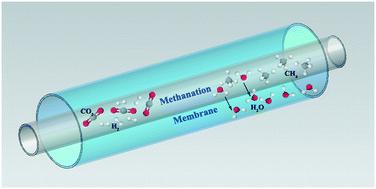当前位置:
X-MOL 学术
›
React. Chem. Eng.
›
论文详情
Our official English website, www.x-mol.net, welcomes your
feedback! (Note: you will need to create a separate account there.)
A CFD study on the performance of CO2 methanation in a water-permeable membrane reactor system
Reaction Chemistry & Engineering ( IF 3.4 ) Pub Date : 2021-11-24 , DOI: 10.1039/d1re00401h Zhewei Liu 1 , Zhoufeng Bian 1 , Zhigang Wang 2 , Bo Jiang 3
Reaction Chemistry & Engineering ( IF 3.4 ) Pub Date : 2021-11-24 , DOI: 10.1039/d1re00401h Zhewei Liu 1 , Zhoufeng Bian 1 , Zhigang Wang 2 , Bo Jiang 3
Affiliation

|
CO2 hydrogenation is one of the important routes for CO2 utilization to address the global warming issue, which has aroused much attention in recent years. A novel water-permeable membrane reactor has been proposed to promote the conversion of CO2 methanation with in situ removal of H2O. However, existing research studies mainly focused on the overall performance and hardly discussed the detailed behavior of water-permeation and methanation inside the membrane reactor, which is crucial for the development of membrane reactors. The main objective of this work is to study the interplay of water permeation and methanation within the membrane reactor, and recommend the appropriate membrane properties and optimal operation conditions. In this regard, a two-dimensional CFD simulation model is built up, and its accuracy is verified by comparison with the literature data. The distribution of the reactant/product species and H2O permeation flux is well presented, and the effects of GHSV, H2O permeance and CO2/H2 permeation selectivity are also investigated. Our results show that the match of methanation reaction rate and H2O permeation rate is crucial. At GHSV of 0.051 s−1, the membrane with a H2O permeance of 7.85 × 10−8 mol m−2 s−1 Pa−1 is capable of removing nearly 90% of H2O produced, leading to an 8.3% increase in CO2 conversion. However, a H2O permeance of magnitude order of 1 × 10−7 mol m−2 s−1 Pa−1 is a prerequisite to provide a significant increase in CO2 conversion at GHSV higher than 0.51 s−1. Besides, it is important to keep H2 and CO2 permeation selectivity lower than 0.1 to avoid the negative effect.
中文翻译:

透水膜反应器系统中CO2甲烷化性能的CFD研究
CO 2加氢是利用CO 2解决全球变暖问题的重要途径之一,近年来备受关注。提出了一种新型透水膜反应器以促进 CO 2甲烷化转化并原位去除 H 2O. 然而,现有的研究主要集中在整体性能上,很少讨论膜反应器内部透水和甲烷化的详细行为,这对膜反应器的发展至关重要。这项工作的主要目的是研究膜反应器内水渗透和甲烷化的相互作用,并推荐合适的膜特性和最佳操作条件。对此,建立了二维CFD仿真模型,并通过与文献数据对比验证了其准确性。反应物/产物种类和 H 2 O 渗透通量的分布,以及 GHSV、H 2 O 渗透率和 CO 2 /H 2 的影响还研究了渗透选择性。我们的结果表明,甲烷化反应速率和H 2 O 渗透速率的匹配是至关重要的。在 0.051 s -1 的GHSV 下,具有7.85 × 10 -8 mol m -2 s -1 Pa -1的 H 2 O 渗透率的膜能够去除产生的近 90% 的 H 2 O,导致 8.3% CO 2转化率增加。然而,数量级为 1 × 10 -7 mol m -2 s -1 Pa -1的 H 2 O 渗透率是提供 CO 2显着增加的先决条件GHSV 转换率高于 0.51 s -1。此外,重要的是保持 H 2和 CO 2渗透选择性低于 0.1 以避免负面影响。
更新日期:2021-12-08
中文翻译:

透水膜反应器系统中CO2甲烷化性能的CFD研究
CO 2加氢是利用CO 2解决全球变暖问题的重要途径之一,近年来备受关注。提出了一种新型透水膜反应器以促进 CO 2甲烷化转化并原位去除 H 2O. 然而,现有的研究主要集中在整体性能上,很少讨论膜反应器内部透水和甲烷化的详细行为,这对膜反应器的发展至关重要。这项工作的主要目的是研究膜反应器内水渗透和甲烷化的相互作用,并推荐合适的膜特性和最佳操作条件。对此,建立了二维CFD仿真模型,并通过与文献数据对比验证了其准确性。反应物/产物种类和 H 2 O 渗透通量的分布,以及 GHSV、H 2 O 渗透率和 CO 2 /H 2 的影响还研究了渗透选择性。我们的结果表明,甲烷化反应速率和H 2 O 渗透速率的匹配是至关重要的。在 0.051 s -1 的GHSV 下,具有7.85 × 10 -8 mol m -2 s -1 Pa -1的 H 2 O 渗透率的膜能够去除产生的近 90% 的 H 2 O,导致 8.3% CO 2转化率增加。然而,数量级为 1 × 10 -7 mol m -2 s -1 Pa -1的 H 2 O 渗透率是提供 CO 2显着增加的先决条件GHSV 转换率高于 0.51 s -1。此外,重要的是保持 H 2和 CO 2渗透选择性低于 0.1 以避免负面影响。











































 京公网安备 11010802027423号
京公网安备 11010802027423号